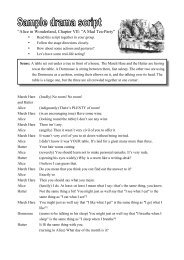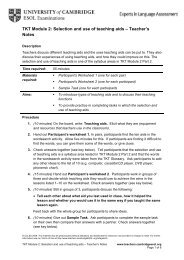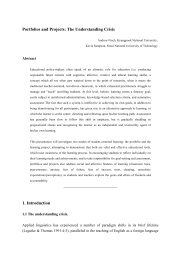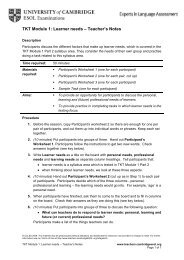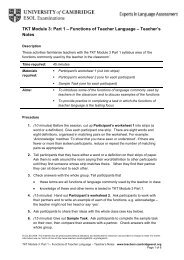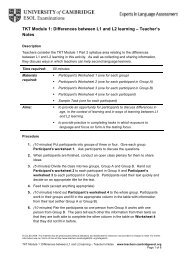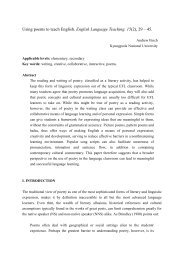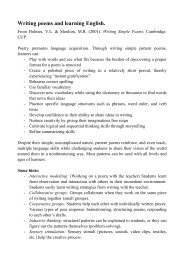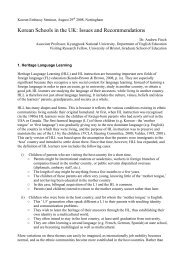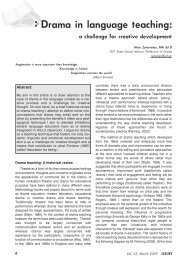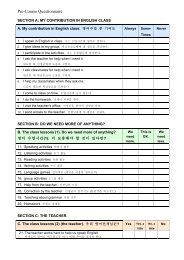Errors in Language Learning and Use - Academy Publisher
Errors in Language Learning and Use - Academy Publisher
Errors in Language Learning and Use - Academy Publisher
Create successful ePaper yourself
Turn your PDF publications into a flip-book with our unique Google optimized e-Paper software.
ISSN 1798-4769<br />
Journal of <strong>Language</strong> Teach<strong>in</strong>g <strong>and</strong> Research, Vol. 1, No. 3, pp. 266-268, May 2010<br />
© 2010 ACADEMY PUBLISHER Manufactured <strong>in</strong> F<strong>in</strong>l<strong>and</strong>.<br />
doi:10.4304/jltr.1.3.266-268<br />
A Tentative Analysis of <strong>Errors</strong> <strong>in</strong> <strong>Language</strong><br />
Learn<strong>in</strong>g <strong>and</strong> <strong>Use</strong><br />
Wenfen Yang<br />
School of Foreign <strong>Language</strong>s, Q<strong>in</strong>gdao University of Science &Technology, Q<strong>in</strong>gdao, Ch<strong>in</strong>a<br />
Email: wfyoung@163.com<br />
Abstract—Everyone tends to make mistakes <strong>in</strong> the process of language learn<strong>in</strong>g <strong>and</strong> use, especially for FL<br />
learners. This paper makes a tentative effort to describe <strong>and</strong> diagnose learners’ errors <strong>in</strong> language learn<strong>in</strong>g<br />
<strong>and</strong> use <strong>in</strong> the hope of help<strong>in</strong>g FL learners’ have a better underst<strong>and</strong><strong>in</strong>g of the errors they made.<br />
Index Terms—error, language learn<strong>in</strong>g, language use, EA, CA<br />
As human be<strong>in</strong>gs, we are bound to make mistakes. If to err <strong>and</strong> to speak are each uniquely human, then to err at<br />
speak<strong>in</strong>g, or to commit language errors, must mark the very p<strong>in</strong>nacle of human uniqueness. S<strong>in</strong>ce language error is the<br />
subject of this paper, let’s provisionally def<strong>in</strong>e a language error as an unsuccessful bit of language. Error Analysis is the<br />
process of determ<strong>in</strong><strong>in</strong>g the <strong>in</strong>cidence, nature, causes <strong>and</strong> consequences of unsuccessful language. The novelty of EA,<br />
dist<strong>in</strong>guish<strong>in</strong>g it from CA, was that the mother tongue was not supposed to enter the picture. <strong>Errors</strong> could be fully<br />
described <strong>in</strong> terms of the TL, without the need to refer to the L1 of the learners.<br />
The Error Analyst’s object of enquiry is the FL learner’s ignorance of the TL. This ignorance can be manifest <strong>in</strong> two<br />
ways. First <strong>in</strong> silence, then <strong>in</strong> the way they compensate for their ignorance, i.e. substitutive language. We need to<br />
dist<strong>in</strong>guish two sorts of silence: cultural silence <strong>and</strong> avoidance. Cultural silence caused by EL2 learners from ‘silent<br />
cultures’ such as F<strong>in</strong>ns or Japanese; while avoidance is <strong>in</strong>duced by ignorance. But learners usually prefer to try to<br />
express themselves <strong>in</strong> the TL by alternative means: they ‘beg, steal or borrow’. This is what we have said before the<br />
substitutive language (called IL). Error Analysts study it <strong>in</strong> relation to the TL.<br />
A. Error Detection<br />
I. THE DESCRIPTION OF ERROR<br />
In the crim<strong>in</strong>al <strong>in</strong>vestigation, a l<strong>in</strong>e-up of <strong>in</strong>dividuals is assembled <strong>and</strong> then let an eyewitness to pick out the<br />
perpetrator of the crime. Analogically, <strong>in</strong> EA we assemble a l<strong>in</strong>e-up of utterances produced or processed by a learner<br />
<strong>and</strong> ask the ‘witness’ or knower to pick out the one or ones that look suspicious, that is , those which are potentially<br />
erroneous. You may th<strong>in</strong>k error detection is simple, but <strong>in</strong> fact it is just the opposite. It is <strong>in</strong>terest<strong>in</strong>g to f<strong>in</strong>d out that to<br />
spot error <strong>in</strong> spoken, <strong>in</strong>formal language is harder than <strong>in</strong> written, formal texts. In addition, spott<strong>in</strong>g one’s own errors is<br />
more difficult than spott<strong>in</strong>g other people’s errors. Even the native speakers sometimes cannot detect error correctly.<br />
B. Locat<strong>in</strong>g <strong>Errors</strong><br />
Error location is <strong>in</strong> the same way with what the police ask an eyewitness to identify the suspect, such as say<strong>in</strong>g he is<br />
the third from the left. However, error location is not always so straightforward; some errors are diffused throughout the<br />
sentence or larger unit of text that conta<strong>in</strong>s them: they are known as global errors. Burt <strong>and</strong> Kiparsky (1972) suggest<br />
that we should identify errors by reference to the TL. And there is a reasonable suggestion: the learners first need to stop<br />
mak<strong>in</strong>g the error, <strong>and</strong> then start to produce the TL form. Gatbonton (1983) adopts the gradual diffusion model of<br />
language change, which suggests that learn<strong>in</strong>g <strong>in</strong>volves two sages: the first is the learn<strong>in</strong>g stage <strong>and</strong> the second <strong>in</strong>volves<br />
extirpat<strong>in</strong>g all the old <strong>and</strong> wrong learn<strong>in</strong>g so only the good ones are left.<br />
C. Describ<strong>in</strong>g <strong>Errors</strong><br />
There are two reasons for why the st<strong>and</strong>ard EA practice of describ<strong>in</strong>g the learner’s errors should be <strong>in</strong> terms of the<br />
TL: firstly, learner’s language <strong>and</strong> TL are co-dialects of the same language, so they should be describable <strong>in</strong> terms of the<br />
same grammar. Secondly, EA is TL-oriented. Accord<strong>in</strong>g to Corder (1981), the system used for the description of<br />
learner’s errors must be one hav<strong>in</strong>g two essential characteristics: 1) the system must be well-developed <strong>and</strong> highly<br />
elaborated, s<strong>in</strong>ce many errors made by even beg<strong>in</strong>ners are remarkably complex. 2) The system should be as simple,<br />
self-explanatory <strong>and</strong> easily learnable as possible. Because of the two characteristics James (1990) po<strong>in</strong>ts out that<br />
Chomsky’s Universal Grammar has little usage for describ<strong>in</strong>g learner errors.<br />
II.<br />
LEVELS OF ERROR<br />
In this part, we recognize three levels of language: the levels of substance, text <strong>and</strong> discourse. If the learner was<br />
operat<strong>in</strong>g the phonological or the graphological substance systems, that is spell<strong>in</strong>g or pronounc<strong>in</strong>g, we say he or she has<br />
© 2010 ACADEMY PUBLISHER
JOURNAL OF LANGUAGE TEACHING AND RESEARCH<br />
267<br />
produced an encod<strong>in</strong>g or decod<strong>in</strong>g error. If he or she was operat<strong>in</strong>g the lexico-grammatical systems of the TL to<br />
produce or process text, we refer to any errors on this level as compos<strong>in</strong>g or underst<strong>and</strong><strong>in</strong>g errors. If he or she was<br />
operat<strong>in</strong>g on the discourse level, we label the errors occurr<strong>in</strong>g misformulation or misprocess<strong>in</strong>g errors.<br />
A. Misspell<strong>in</strong>gs.<br />
There are four types of misspell<strong>in</strong>g: the first one is punctuation errors, among which the most frequent are overuse of<br />
the exclamation (!) by some writers; misorder<strong>in</strong>g of clos<strong>in</strong>g <strong>in</strong>verted comas; under or overuse of capitals; over <strong>in</strong>clusion<br />
of a comma between an antecedent <strong>and</strong> a restrictive relative clause; <strong>and</strong> misselection of the colon <strong>in</strong>stead of the comma<br />
after the salutation <strong>in</strong> letters. The second one is typographic errors. People who are normally good spellers might be<br />
poor typists. Their problem is <strong>in</strong> automatiz<strong>in</strong>g the required temporal <strong>and</strong> spatial mechanisms that underlie skilled<br />
f<strong>in</strong>ger<strong>in</strong>g on the typewriter, or keystrokes on the word-processor. In fact, we are deal<strong>in</strong>g here with mistakes rather than<br />
errors, <strong>and</strong> this probably expla<strong>in</strong>s why psychologists <strong>in</strong>terested <strong>in</strong> skill learn<strong>in</strong>g have paid more attention to typ<strong>in</strong>g<br />
errors than applied l<strong>in</strong>guists have. The third on is dyslexic errors. Some of the errors dyslexics make are MSs: e.g.<br />
for is a misselection from two letters that can represent the same sound 〔k〕<strong>in</strong> English. Dyslexics also<br />
produce errors that are not MSs, e.g. for <strong>in</strong>volv<strong>in</strong>g the reversal of the letter <strong>in</strong>to or<br />
strephosymbolia. The fourth one is confusibles. Let’s look at the amus<strong>in</strong>g example given by Carney (1994): ‘to marry a<br />
devoiced woman’ <strong>and</strong> observes that these are lexical errors <strong>in</strong>volv<strong>in</strong>g confusion between similar sound<strong>in</strong>g morphemes<br />
<strong>and</strong> words. Perhaps literacy raises people’s awareness of differences to the po<strong>in</strong>t where they can avoid such confusions<br />
<strong>in</strong> their writ<strong>in</strong>g at least.<br />
B. Lexical <strong>Errors</strong>.<br />
Accord<strong>in</strong>g to Chomsky (1980) lexis is sharply different from grammar. Grammar is said to be organized <strong>in</strong> closed<br />
systems, to be systematic <strong>and</strong> regular. Lexis is, by contrast, said to consist of open systems, to be irregular <strong>and</strong><br />
unsystematic. Recently, lexis has begun to take a central role <strong>in</strong> language study. There are a number of reasons for this.<br />
First, the boundaries between lexis <strong>and</strong> grammar are now seen to be less clear-cut than was assumed. Morphological<br />
aspects of words, which used to be treated as part of grammar, can just as well be viewed as part of the word: e.g. words<br />
of different form classes can be derived from the same root: bright→ brightness→ brightly. Secondly, learners<br />
themselves believe that vocabulary is very important <strong>in</strong> language learn<strong>in</strong>g. Though this view may not be correct, it is<br />
likely to <strong>in</strong>fluence learn<strong>in</strong>g. Thirdly, for some learner groups, lexical errors are the most frequent category of error.<br />
Fourthly, native speakers consider the lexical errors <strong>in</strong> learners’ IL to be more disruptive <strong>and</strong> irritat<strong>in</strong>g than other types.<br />
F<strong>in</strong>ally, vocabulary carries a particularly heavy functional load, especially <strong>in</strong> early IL. There is little grammar <strong>in</strong> such IL,<br />
<strong>and</strong> the message often has to be <strong>in</strong>ferred, ma<strong>in</strong>ly from the lexical terms assembled for its representation.<br />
We classify lexical errors from two perspectives: formal errors <strong>and</strong> semantic errors. Formal errors of lexis <strong>in</strong>clude<br />
formal misselection, misformations <strong>and</strong> distortions. Semantic errors <strong>in</strong> lexis refer to confusion of sense relations <strong>and</strong><br />
collocational errors.<br />
C. Pragmatic <strong>Errors</strong>.<br />
Pragmatic errors <strong>in</strong>volve putt<strong>in</strong>g l<strong>in</strong>guistic knowledge <strong>in</strong>to practice, so we may call them pragmal<strong>in</strong>guistic deviations.<br />
They arise when ever speakers misencode a message, not to the detriment of its mean<strong>in</strong>g but to the detriment of its<br />
pragmatic force, that is, what speech act it is <strong>in</strong>tended to perform or what rhetorical force it should carry. On the other<br />
h<strong>and</strong>, there are discoursal or <strong>in</strong>teractional gaffes that arise not out of l<strong>in</strong>guistic <strong>in</strong>competence but out of sociocultural<br />
<strong>in</strong>competence. Thomas (1983) calls it sociopragmatic failure. Sociopragmatic failures result from culture-clashes, from<br />
cultural differences of view concern<strong>in</strong>g what is appropriate social behavior <strong>in</strong> certa<strong>in</strong> sett<strong>in</strong>gs. There are a number of<br />
sources of such <strong>in</strong>felicities, such as taboos, size of the imposition, values <strong>and</strong> power <strong>and</strong> social distance.<br />
III.<br />
DIAGNOSING ERRORS<br />
James (1990) once commented on the desirability of dist<strong>in</strong>guish<strong>in</strong>g between error description <strong>and</strong> error diagnosis.<br />
There is widespread acceptance of this pr<strong>in</strong>ciple: Dulay, Burt <strong>and</strong> Krashen (1982) clearly state that ‘the accurate<br />
description of errors is a separate activity from the task of <strong>in</strong>ferr<strong>in</strong>g the sources of those errors’. We might ask what<br />
motivates this <strong>in</strong>sistence on keep<strong>in</strong>g description <strong>and</strong> diagnosis separate. To illustrate it more clearly, let’s look at how<br />
doctors diagnose diseases: sick patients visit<strong>in</strong>g the doctor show visible signs of their illnesses, which the doctor<br />
describes <strong>in</strong> order to reach a diagnosis. In addition, the patients are usually asked to describe their sensation to the<br />
doctor, who <strong>in</strong>terprets this account <strong>in</strong> terms of a diagnosis. The same is true for EA. The diagnosis question is therefore<br />
one that transcends description <strong>and</strong> <strong>in</strong>vokes explanation, trac<strong>in</strong>g errors to their causes, sometimes called error etiology.<br />
The ultimate cause of error is ignorance of the TL item aimed at. It is worth not<strong>in</strong>g that any formal deviance can have<br />
either declarative or procedural causes. When the required TL item is unknown <strong>and</strong> the learner borrows an L1substitute,<br />
the consequence is an L1 transfer error, but when the learner knows the TL item but fails to access it, <strong>and</strong> <strong>in</strong>stead<br />
accesses an L1 substitute, we have a case of an L1 <strong>in</strong>terference mistake.<br />
There is general agreement over the ma<strong>in</strong> diagnosis-based categories of error. There are four major categories:<br />
<strong>in</strong>terl<strong>in</strong>gual, <strong>in</strong>tral<strong>in</strong>gual, communication-strategy <strong>and</strong> <strong>in</strong>duced.<br />
© 2010 ACADEMY PUBLISHER
268<br />
JOURNAL OF LANGUAGE TEACHING AND RESEARCH<br />
The clearest proof of L1 <strong>in</strong>terference is where L1 nonst<strong>and</strong>ard dialect features get transferred to L2. let’s look at an<br />
example made by L1 Portuguese learners of EL2: the fronted preposition <strong>in</strong> With who did he come N<strong>in</strong>ety-n<strong>in</strong>e per<br />
cent of the time the learners might prefer: Who did he come with Now when they come to learn French or German,<br />
they will have a problem, s<strong>in</strong>ce <strong>in</strong> these languages the preposition must be fronted. Failure to do so results <strong>in</strong> errors like<br />
Wem ist er gekommen*mit<br />
Intral<strong>in</strong>gual errors are based on learn<strong>in</strong>g strategy. The author gives us a list of errors. We will discuss some of them: 1)<br />
false analogy: the learner wrongly assumes that the new item B behaves like A, e.g. boy→boys, then child→* childs. 2)<br />
Misanalysis: the learners have formed a hunch or hypothesis concern<strong>in</strong>g an L2 item, which they are now putt<strong>in</strong>g <strong>in</strong>to<br />
practice. The hypothesis is not based on L1 knowledge at all, e.g. ‘T<strong>in</strong>ker, Tailor’, as every story *who tells about<br />
spies…The learner has hypothesized that s<strong>in</strong>ce the book’s title refers to humans, therefore the 〔+ human〕relative<br />
pronoun should be selected. 3) Hypercorrection: this results from the learners over-monitor<strong>in</strong>g their L2 output, <strong>and</strong><br />
attempt<strong>in</strong>g to be consistent, so it is ak<strong>in</strong> to system simplification: Ⅱ est descendu et *est (a) attendu. The learner seems<br />
to have learnt that the marked auxiliary etre is used with descendre but wrongly assumes that it should also be used with<br />
attendre.<br />
Communication strategy-based errors <strong>in</strong>clude holistic strategies <strong>and</strong> analytic strategies. The term ‘holistic’ refers to<br />
the learners’ assumption that if you can say X <strong>in</strong> the L2, then you must be able to say Y. The most general term for this<br />
is approximation. It takes on a number of forms, the first of which is to use a near synonym, e.g.* credibility for the<br />
<strong>in</strong>tended truth. Alternatively, one can use a superord<strong>in</strong>ate term: *fruits for blackberries. A third option is to use an<br />
antonym or opposite, <strong>and</strong> fourth option is to co<strong>in</strong> a word. Analytic strategies express the concept <strong>in</strong>directly, by allusion<br />
rather than by direct reference: this is circumlocution. The learners identify one or more criterial attributes of the<br />
referent <strong>and</strong> mention these <strong>in</strong> an attempt to refer to the entity <strong>in</strong> question.<br />
Induced errors was first used by Stenson (1983) to refer to learner errors ‘that result more from the classroom<br />
situation than from either the students’ <strong>in</strong>complete competence <strong>in</strong> English grammar or first language <strong>in</strong>terference’.<br />
Some of what Stenson (1983) calls <strong>in</strong>duced errors could be expla<strong>in</strong>ed <strong>in</strong> terms of the diagnostic categories we have<br />
outl<strong>in</strong>ed above. Similarly, there are those errors <strong>in</strong>duced by imprecise teacher explanations: for example, the<br />
pedagogical ‘explanation’ which dist<strong>in</strong>guishes the modals should <strong>and</strong> must on the grounds that the former is ‘stronger’<br />
than the second. The error precipitated was we *should have worked <strong>in</strong> order to buy clothes, but we *must have worked<br />
<strong>in</strong> order to eat. The learners are attempt<strong>in</strong>g to convey the idea that it is less important to spend money on clothes than<br />
on food. In fact the learners have hypothesized a false concept not on the basis of their own analysis of <strong>in</strong>put but on that<br />
of their teacher’s mediation of the lexical opposition.<br />
IV.<br />
CONCLUSION<br />
Error analysts claim that learners’ errors, to a large degree, are not caused by the <strong>in</strong>fluence of their L1; <strong>in</strong>stead, their<br />
errors reflect some common learn<strong>in</strong>g strategies. EA tries to f<strong>in</strong>d out the regular th<strong>in</strong>gs <strong>in</strong> the process of foreign language<br />
learn<strong>in</strong>g through the study of learners’ errors. In this way it has a great contribution for FL teach<strong>in</strong>g: teachers should be<br />
sensitive to their students’ errors <strong>and</strong> summarize what k<strong>in</strong>d of error students are most likely to make at certa<strong>in</strong> period,<br />
<strong>and</strong> then modify their teach<strong>in</strong>g materials <strong>in</strong> order to adapt to the students’ need.<br />
REFERENCES<br />
[1] Burt, M. <strong>and</strong> Kiparsky, C. (1972). The Gooficon: A Repair Manual for English. Newbury House, Rowley, MA.<br />
[2] Carney, E. (1994). A Survey of English Spell<strong>in</strong>g. Routledge, London.<br />
[3] Chomsky, N. (1980). Rules <strong>and</strong> Representations. Blackwell, Oxford.<br />
[4] Corder, S.P. (1981). Error Analysis <strong>and</strong> Interlanguage. Oxford University Press, Oxford.<br />
[5] Dulay, H., Burt, M. <strong>and</strong> Krashen, S.D. (1982). <strong>Language</strong> Two. Newbury House, Rowley, MA.<br />
[6] Gatbonton, E. (1983). Patterned phonetic variability <strong>in</strong> second language speech: a gradual diffusion model, <strong>in</strong> B.W. Rob<strong>in</strong>ett<br />
<strong>and</strong> J. Schachter (eds), Second <strong>Language</strong> Learn<strong>in</strong>g: Contrastive Analysis, Error Analysis <strong>and</strong> Related Aspects. University of<br />
Michigan Press, Ann Arbor, MI. pp. 240-55.<br />
[7] James, Carl. (1990). Learner language, <strong>Language</strong> Teach<strong>in</strong>g Vol. 23 No. 4: 205-13.<br />
[8] James, Carl <strong>and</strong> Garrett, P. (eds) (1991). <strong>Language</strong> Awareness <strong>in</strong> the Classroom. Longman, London.<br />
[9] Stenson, N. (1983). Induced errors, <strong>in</strong> B.W. Rob<strong>in</strong>ett <strong>and</strong> J. Schachter (eds), Second <strong>Language</strong> Learn<strong>in</strong>g: Contrastive Analysis,<br />
Error Analysis <strong>and</strong> Related Aspects. University of Michigan Press, Ann Arbor, MI. pp. 256-71.<br />
[10] Thomas, J. (1983). Cross-cultural pragmatic failure, Applied L<strong>in</strong>guistics Vol. 4 No. 2: 91-112.<br />
Wenfen Yang was born <strong>in</strong> Sh<strong>and</strong>ong, Ch<strong>in</strong>a <strong>in</strong> 1965. She received her M.A. degree <strong>in</strong> l<strong>in</strong>guistics from Sh<strong>and</strong>ong Teachers’<br />
University, Ch<strong>in</strong>a <strong>in</strong> 1993.<br />
She is currently an associate professor <strong>in</strong> the School of Foreign <strong>Language</strong>s, Q<strong>in</strong>gdao University of Science & Technology,<br />
Q<strong>in</strong>gdao, Ch<strong>in</strong>a. Her research <strong>in</strong>terests <strong>in</strong>clude l<strong>in</strong>guistics <strong>and</strong> translation.<br />
© 2010 ACADEMY PUBLISHER



